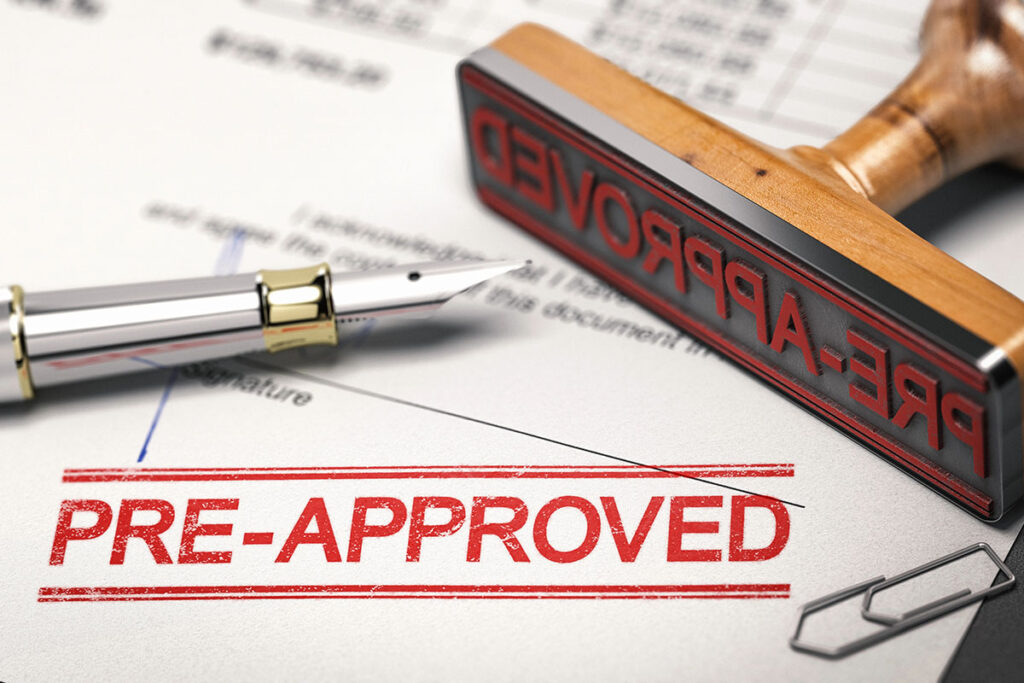Getting pre-approved for a mortgage is an important step in the home buying journey. It simplifies the mortgage process, establishes a clear budget, and strengthens your position as a buyer in a competitive market.
Importance of Mortgage Pre-Approval
- Establishes Credibility: Sellers prefer buyers with pre-approval letters indicating financial readiness.
- Streamlines Home Search: Knowing your budget helps you focus on homes within your price range.
Overview of the Steps Involved in Getting Pre-Approved
- Assess Your Financial Situation: Evaluate income, expenses, and credit scores.
- Gather Necessary Documents: Prepare identification, income verification, and asset documentation.
- Contact Lenders: Choose between local banks and online lenders.
- Undergo Credit Check and Evaluation: Understand what lenders look for during this assessment.
- Receive Pre-Approval Letter: This letter outlines loan amounts and terms.
Benefits of Being Pre-Approved
- Buyers gain confidence in their purchasing power.
- A pre-approval letter can expedite the offer process on desired homes.
- Enhances negotiation leverage with sellers.
Taking these steps can significantly enhance your home buying experience.
Understanding Mortgage Pre-Approval
Mortgage pre-approval is often confused with prequalification, but these terms have distinct meanings.
Pre-Qualification vs Pre-Approval
- Pre-qualification involves a basic assessment of your financial situation based on self-reported information. It does not require documentation and provides a rough estimate of how much you might borrow.
- Pre-approval, on the other hand, requires a thorough review of your financial documents by a lender. This process includes verifying your credit score, income, employment, and debts. A pre-approval letter indicates that the lender is willing to extend a certain loan amount under specified terms.
The importance of mortgage pre-approval cannot be overstated for serious home buyers. It demonstrates financial readiness to sellers, making you a more attractive candidate in competitive markets. Sellers are more likely to negotiate favorably with buyers who have proven their ability to secure financing.
In addition, having a pre-approval strengthens your position when making an offer on a home. It establishes trust with sellers and encourages them to view your offer as credible, potentially giving you an edge over other buyers who may only be pre-qualified or unverified.
Steps to Getting Pre-Approved for a Mortgage in Texas
Obtaining pre-approval for a mortgage is a structured process that involves several crucial steps. This preparation establishes your financial readiness and enhances your position as a buyer.
1. Assess Your Financial Situation
Understanding your financial landscape is essential before initiating the pre-approval process. Key components include:
- Evaluating Income and Expenses: Calculate your monthly income from all sources, including salaries, bonuses, and any supplementary income. Compare this against your monthly expenses such as bills, groceries, and other obligations.
- Understanding Credit Scores: Your credit score significantly impacts mortgage rates. A higher score typically results in better rates. Familiarize yourself with the factors that influence your score, such as payment history and credit utilization.
- Debt-to-Income Ratio (DTI): This ratio measures your monthly debt payments against your gross monthly income. In Texas, lenders prefer a DTI under 43%. A lower DTI indicates better financial health and increases your chances of mortgage approval.
2. Gather Necessary Documents
Collecting the right documentation streamlines the pre-approval process. Essential documents include:
- Identification: A government-issued ID such as a driver’s license or passport.
- Income Verification: Recent pay stubs, W-2 forms, and tax returns for at least the past two years help verify your earnings.
- Asset Documentation: Bank statements, retirement account statements, and any other proof of assets are essential to demonstrate financial stability.
Accurate and complete documentation is vital for the lender’s assessment. Missing or incorrect information may delay or jeopardize your pre-approval.
3. Contact Lenders
Choosing the right lender can significantly affect your mortgage experience. Consider these options:
- Local Banks vs. Online Lenders: Local banks often have insight into Texas-specific programs and regulations, while online lenders can provide competitive rates and convenience. Evaluate both to find what suits you best.
- Role of Loan Officers: A loan officer will guide you through the pre-approval process, helping you understand different loan options available in Texas. They can answer questions regarding fees, interest rates, and required documentation.
Establishing a relationship with a loan officer can also create rapport that may benefit you later in negotiations.
4. Undergo Credit Check and Evaluation
Once you’ve submitted your documents, lenders will conduct a credit check to evaluate your creditworthiness. Key elements they assess include:
- Credit Report Review: Lenders examine your credit report for any red flags such as late payments or high credit utilization ratios.
- Underwriting Process: Underwriters analyze all submitted information to determine borrower eligibility. This process verifies that you meet lending guidelines based on income stability, assets, and overall risk profile.
A thorough evaluation at this stage can prevent issues down the line when applying for final mortgage approval.
5. Receive Pre-Approval Letter
Upon successful completion of the previous steps, you will receive a pre-approval letter containing critical information:
- Loan Amount: The maximum amount the lender is willing to offer based on your financial situation.
- Interest Rate: The rate that will apply if you proceed with the mortgage application.
This letter is an invaluable tool in the home buying process. It signals to sellers that you are a serious buyer and can expedite negotiations for your potential new home.
Getting pre-approved lays down a strong foundation for home buying. Taking these systematic steps ensures you’re equipped for one of life’s most significant investments without overlooking key financial elements or documentation requirements.
Types of Mortgages Available in Texas
Texas residents have several mortgage options to choose from, catering to various financial situations and home buying goals. Here’s a brief overview of the most common types of mortgages available:
- Conventional Loans: Typically requiring a down payment of 5% to 20%, these loans are not insured by the government and usually offer competitive interest rates for borrowers with good credit.
- FHA Loans: Backed by the Federal Housing Administration, these loans allow for down payments as low as 3.5%. They are ideal for first-time homebuyers or those with lower credit scores.
- VA Mortgage Loans: Exclusively available to veterans and active-duty military members, VA loans come with no down payment requirement and favorable terms, making them a highly sought-after option.
- USDA Loans: Designed for rural homebuyers, USDA loans require no down payment and have income limitations. They are perfect for individuals looking to purchase in eligible rural areas.
- Jumbo Mortgages: For properties exceeding conforming loan limits, jumbo mortgages are necessary. These loans often have stricter credit requirements and higher interest rates due to their size.
Understanding these types of mortgages can help you make informed decisions during your journey toward homeownership.
First-Time Home Buyer Resources in Texas
Texas offers a variety of state-backed down payment assistance programs tailored for first-time home buyers. These programs aim to make homeownership more accessible and affordable. Key options include:
- TDHCA Home Buyer Programs: This initiative provides low-interest loans and down payment assistance to eligible buyers, helping them manage upfront costs.
- My First Texas Home Program: This program combines low-interest loans with grants that can cover up to 5% of the loan amount for down payments.
These resources are designed to support first-time buyers as they navigate the journey of purchasing a home. Eligibility typically hinges on income limits, credit scores, and other factors specific to each program. Taking advantage of these opportunities can be a significant step toward achieving your goal of homeownership.
Understanding the Mortgage Application Process in Texas
After receiving your pre-approval, the mortgage application process moves forward with several critical steps. Understanding the mortgage application process helps streamline your home buying journey.
- Final Documentation: Submit any additional documents requested by your lender. This may include updated financial statements or proof of employment.
- Underwriting: Lenders evaluate your financial stability through a detailed underwriting process. Underwriters verify income, assets, and creditworthiness, ensuring you meet their standards.
- Conditional Approval: You may receive conditional approval, which requires specific conditions to be met before final approval is granted.
- Appraisal: An appraisal is conducted to assess the property’s value, ensuring it aligns with the loan amount.
- Final Approval Timeline: Expect final approval within 2-4 weeks after completing all requirements, clearing you for the closing process.
Understanding these steps facilitates a smoother experience as you navigate your mortgage application.
Closing Costs and Final Steps
When purchasing a home in Texas, it’s crucial to be aware of the typical closing costs associated with the transaction. These costs can vary significantly but generally include:
- Title Insurance Fees: This protects against any defects in the title that may arise after purchase. In Texas, these fees typically range from $1,000 to $1,500 for standard policies.
- Escrow Fees: Charged for handling the transaction, these fees usually amount to $200 to $400. Additional attorney fees may apply, contributing anywhere from $500 to $1,000, depending on your location.
Understanding these costs prepares you for the final steps of your mortgage journey. Anticipate additional expenses such as home inspections and appraisals. As you approach closing day, ensure all necessary arrangements are in place to facilitate a smooth transition into your new home.
Moving Forward with Confidence
Taking the steps to getting pre-approved for a mortgage in Texas sets a strong foundation for your home-buying journey. Consider these essential actions:
- Assess your financial situation: Understand your income, expenses, and credit score.
- Gather necessary documents: Ensure you have all the required paperwork ready for lenders.
- Contact lenders: Research and choose the right lender for your needs.
- Undergo credit check and evaluation: Be aware of what lenders seek during this process.
- Receive your pre-approval letter: Utilize this tool to strengthen your bargaining position.
Embrace the process of becoming financially ready. Making informed decisions today will pave the way for a successful home purchase.
Frequently Asked Questions About Pre-Approval Mortgage
What is the difference between mortgage pre-approval and prequalification?
Mortgage pre-approval involves a thorough evaluation of your financial situation by a lender, including a credit check, to determine how much you can borrow. In contrast, prequalification is a less formal process where you provide basic financial information to get an estimate of what you might qualify for.
Why is mortgage pre-approval important for home buyers in Texas?
Mortgage pre-approval is crucial for serious home buyers because it strengthens your position in the market. It shows sellers that you are a qualified buyer, which can give you an edge in competitive housing markets.
What documents are needed for mortgage pre-approval in Texas?
To get pre-approved for a mortgage, you’ll need to gather essential documents such as identification, income verification (like pay stubs or tax returns), and asset documentation. Accurate and complete paperwork is vital for the lender’s assessment.
How do I choose the right lender for my mortgage in Texas?
When choosing a lender, consider factors such as their reputation, loan options available (local banks vs. online lenders), and customer service. Consulting with loan officers can also help guide you through the pre-approval process.
What types of mortgages are available to Texas residents?
Texas offers various mortgage options including conventional loans, FHA loans, VA loans, USDA loans, and jumbo mortgages. Each type has different eligibility requirements and benefits suited to different buyer needs.
What should I expect during the mortgage application process after pre-approval?
After receiving your pre-approval letter, you will enter the formal mortgage application process. This involves submitting additional documentation, undergoing underwriting evaluations, and waiting for final approval before closing on your new home.










